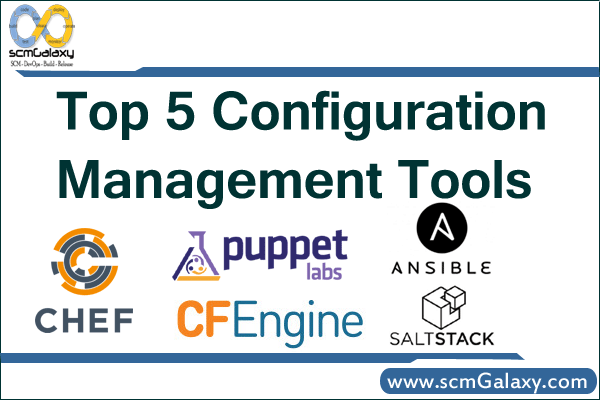

Top 5 Configuration Management Tools
In computing, Puppet is an open-source configuration management utility. It runs on many Unix-like systems as well as on Microsoft Windows, and includes its own declarative language to describe system configuration.
Puppet is produced by Puppet Labs, founded by Luke Kanies in 2005. It is written in Ruby and released as free software under the GNU General Public License (GPL) until version 2.7.0 and the Apache License 2.0 after that.
What started out as a popular DevOps tool has quickly become a movement. Written in Ruby, like Chef, Puppet also comes in both an open source and enterprise version. However, where Chef has a healthy offering of features across both open source and enterprise versions, Puppet has placed the majority of its feature set into enterprise status. Features that the open source version comes with include provisioning (Amazon EC2, Google Compute Engine), configuration management (operating systems and applications) plus 2,000+ pre-built configurations on Puppet Forge. Considerably more features are available for the enterprise version, including the open source features plus graphical user interface, event inspector (visualize infrastructure changes), supported modules, and provisioning (VMware VMs). Configuration management (discovery, user accounts), orchestration, task automation, role-based access control (with external authentication support) are also included. Puppet enterprise has a unified cross-platform installer of all components and support.
Offered as both an open source and enterprise product, Chef is a powerful tool for full IT infrastructure configuration management. With open source Chef at the heart of both offerings, shared features include a flexible and scalable automation platform, access to 800+ reusable cookbooks and integration with leading cloud providers. Chef also offers enterprise platform support, including Windows and Solaris, and allows you to create, bootstrap and manage OpenStack clouds. It has easy installation with ‘one-click’ Omnibus Installer, automatic system discovery with Ohai, text-based search capabilities and multiple environment support. Other notable features inclyde the “Knife” command line interface, “Dry Run” mode for testing potential changes, and the ability to manage 10,000+ nodes on a single Chef server. Features only available in the enterprise version of Chef include availablility as a hosted service, enhanced management console, centralized activity and resource reporting, as well as “Push” command and control client runs. Multi-tenancy, role-based access control (RBAC), high availability installation support and verification, along with centralized authentication using LDAP or Active Directory are included with Chef enterprise.
Ansible is a model-driven configuration management tool that leverages SSH to improve security and simplify management. In addition to configuration management, it is capable of automating app deployment (even multi-tier deployment), workflow orchestration and cloud provisioning, hence the company likes the tool to be categorized as an “orchestration engine.” Ansible is built on five design principles including ease of use (doesn’t require writing scripts or custom code), low learning curve (both for sysadmins and developers), comprehensive automation (allowing you to automate almost anything in your environment), efficiency (since it runs on OpenSSH it doesn’t rely on memory or CPU resources), and security (it is inherently more secure because it doesn’t require an agent, additional ports or root level daemons). As many other open source projects, Ansible has a paid product that comes in the form of a web UI called Ansible Tower.
One of the earliest full-featured configuration management systems out there, CFEngine has gone through several iterations and maintained relevance as OS have gone from the local data center to the cloud. At the heart of the infrastructure automation framework, CFEngine is also a modeling and monitoring compliance engine, capable of sitting on a small footprint. As recommended by CFEngine, steps toward identifying an initial desired state include: 1) model the desired state of your environment; 2) simulate configuration changes before committing them; 3) confirm the desired state and set for automatic self-healing; 4) collect reports on the differences between actual and desired states. CFEngine has a library of reusable data-driven models that will help users model their desired states. These infrastructure patterns are designed to be reusable across the Enterprise.
As part of a larger, enterprise ready application, the configuration management piece of Salt is as robust and feature-full as would be expected. Built upon the remote execution core, execution of the system occurs on “minions” which receives commands from the central Salt master and replies with the results of said commands. Salt support simultaneous configuration of tens of thousands of hosts. Based upon host “states”, no programming is required to write the configuration files, which are small and easy to understand, that help identify the state of each host. Additionally, for those who do program, or admins who want to have more control and familiarity with their configuration files, any language can be used to render the configurations.
I’m a DevOps/SRE/DevSecOps/Cloud Expert passionate about sharing knowledge and experiences. I am working at Cotocus. I blog tech insights at DevOps School, travel stories at Holiday Landmark, stock market tips at Stocks Mantra, health and fitness guidance at My Medic Plus, product reviews at I reviewed , and SEO strategies at Wizbrand.
Please find my social handles as below;
Rajesh Kumar Personal Website
Rajesh Kumar at YOUTUBE
Rajesh Kumar at INSTAGRAM
Rajesh Kumar at X
Rajesh Kumar at FACEBOOK
Rajesh Kumar at LINKEDIN
Rajesh Kumar at PINTEREST
Rajesh Kumar at QUORA
Rajesh Kumar at WIZBRAND

 Starting: 1st of Every Month
Starting: 1st of Every Month  +91 8409492687
+91 8409492687  Contact@DevOpsSchool.com
Contact@DevOpsSchool.com
